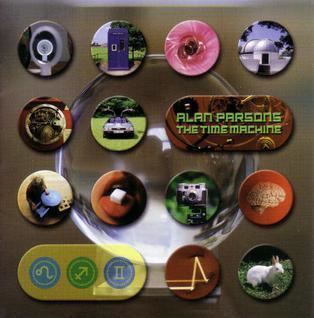Released 28 September 1999 Release date 28 September 1999 | Length 51:50 Artist Alan Parsons Label Miramar | |
 | ||
Similar Alan Parsons albums, Progressive rock albums | ||
Alan parson s project the time machine full album
The Time Machine is the third solo album produced and engineered by Alan Parsons following the split of The Alan Parsons Project.
Contents
- Alan parson s project the time machine full album
- Alan parsons the time machine 1999
- Albums concept
- Track listing
- Bonus Tracks
- Personnel
- Lyrics
- Songs
- References
While the sound of this album is recognizably similar in style to some of the soft, ethereal tracks from certain Alan Parsons Project albums, it is noteworthy that none of the writing or performance credits in the sleeve notes (of the CD edition) go to Alan Parsons, except for one short and simple instrumental part on "Temporalia", and that the album lacks much of the rock edge of the previous albums; his relation to the album is almost exclusively as producer. "The Time Machine" (Parts 1 and 2) are in a similar style to that of Robert Miles's first album Dreamland, and not to other Alan Parsons instrumental tracks or the rest of this album.
The track list here is from the North American release; on the Japanese release, the instrumental here called "The Time Machine," is named "H.G. Force" (a reference to H.G. Wells) and a bonus track titled "Beginnings" is also included.
Alan parsons the time machine 1999
Album's concept
The themes of time, time travel, and memory of the past had been suggested by Parsons as subject matter for the second Alan Parsons Project album, but writing partner Eric Woolfson favoured a purely futuristic theme of robotic beings eventually displacing the human race, which eventually resulted in the album I Robot.
"Temporalia" features a narration by professor Frank Close on the idea of the universe itself acting as a sort of time machine, whilst "Press Rewind" ponders what we might do if we were able to reverse time, and change decisions we have made. The track "The Call of the Wild" is notable for featuring the vocal talent of Máire Brennan from Clannad with lyrics and music by Ian Bairnson.
The album cover has several images related to time and popular time-travel icons, including a photography camera, a clock mechanism, a police box as a reference to the TARDIS in Doctor Who, as well as a wormhole-like tunnel effect from the opening sequence; a DeLorean DMC-12 sportscar referring to the Back to the Future series; and a child playing with a model ship from the Star Trek franchise.
Track listing
- "The Time Machine (Part 1)" – (Stuart Elliott) Instrumental – 4:54
- "Temporalia" – (Parsons) Instrumental with narration by Professor Frank Close – 1:00
- "Out of the Blue" – (Bairnson) Lead Vocal Tony Hadley of Spandau Ballet – 4:54
- "Call Up" – (Bairnson) Lead Vocal Neil Lockwood – 5:13
- "Ignorance Is Bliss" – (Bairnson) Lead Vocal Colin Blunstone of The Zombies and The Alan Parsons Project – 6:45
- "Rubber Universe" – (Bairnson) Instrumental – 3:52
- "The Call of the Wild" – (Bairnson) Lead Vocal Máire Brennan of Clannad – 5:22
- "No Future in the Past" – (Elliott) Lead Vocal Neil Lockwood – 4:46
- "Press Rewind" – (Elliott) Lead Vocal Graham Dye – 4:20
- "The Very Last Time" – in memory of Gemma (Bairnson) Lead Vocal Beverley Craven – 3:42
- "Far Ago And Long Away" – (Bairnson) Instrumental – 5:14
- "The Time Machine (Part 2)" – (Elliott) Instrumental – 1:47
The title track is heavily influenced by the Dream Trance style of Robert Miles, indicating a change in style that would be continued on the next album, A Valid Path.
Bonus Tracks
- "Beginnings" – Instrumental – 4:31
- "Dr. Evil (edit)" – Lead Vocal Mike Myers) – 3:23
"Dr. Evil (edit)," features the voice of Mike Myers from the second Austin Powers movie, The Spy Who Shagged Me, in which The Alan Parsons Project is mentioned. It is available on most releases which feature a bonus track. "Beginnings" is available only on the Japanese release.
Personnel
Lyrics
The lyrics in this album, like many other albums of Alan Parsons and Alan Parsons Project, are around a central theme, in this case H.G. Wells novel The Time Machine, but touch other themes related to relativity and time travelling.
Songs
1The Time Machine - Part 14:55
2Temporalia1:01
3Out of the Blue4:55
